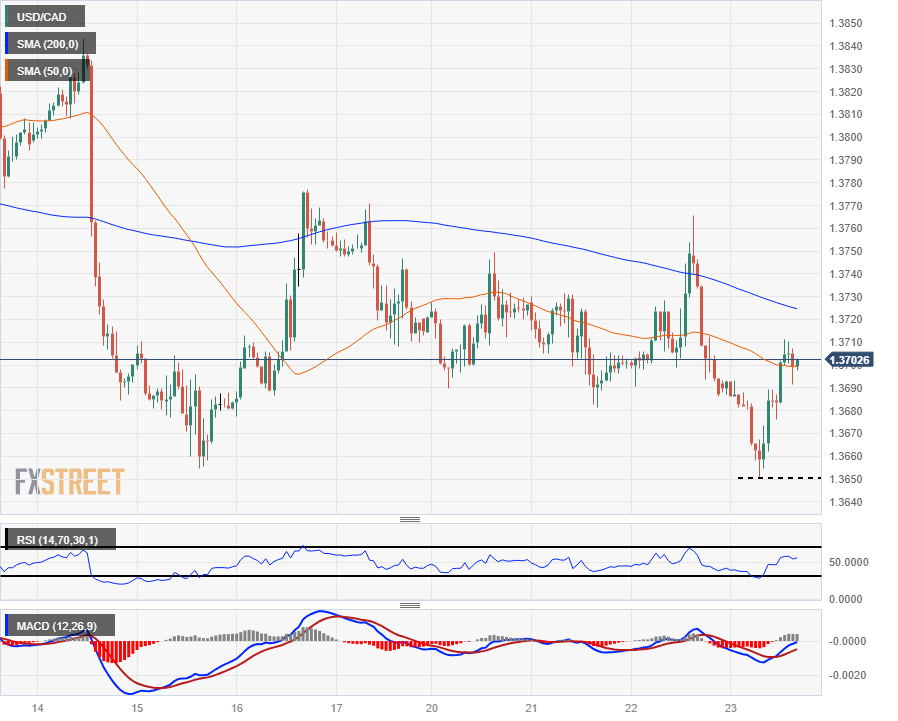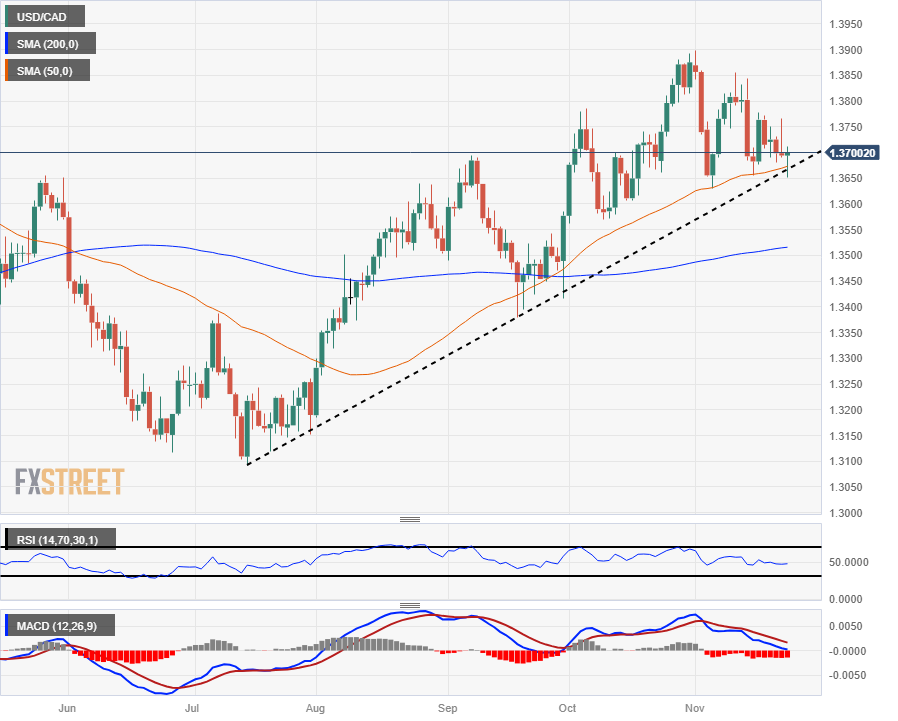- The Canadian dollar takes a pause, while the CAD market remains sideways.
- Canada’s retail sales on Friday will be overshadowed by US PMIs.
- Thursday will be a quiet session with the US away for Thanksgiving.
The Canadian Dollar (CAD) is steady on Thursday, with USD/CAD trading near the day’s opening bids. On Friday, US stock markets will return to the fold for a day of reduced trading before closing again for the weekend.
Canada’s latest round of retail sales will also be released on Friday, but the release is likely to be overshadowed by the release of the U.S. Purchasing Managers’ Index (PMI).
Daily Market Moves Summary: Canadian Dollar Barely Moving, Capped by Slightly Weaker Crude Oil
- The Canadian Dollar moves lower as US holiday trading volumes deflate market momentum.
- The Canadian dollar initially rose, but quickly retreated to Thursday’s opening bids.
- Crude oil is experiencing some bearishness, limiting CAD support.
- In a speech Wednesday, Bank of Canada (BOC) Governor Tiff Macklem noted that BOC policymakers “could” have done enough to control inflation and balance the economy.
- Friday’s CAD retail sales will have limited impact as traders focus on US PMIs.
- The median market forecast expects flat results or slight declines in both data series.
- CAD Retail Sales in September are expected to be 0.0%, up from -0.1% previously.
- Retail sales excluding vehicles are expected to reveal a -0.2% decline in consumer spending.
- In the United States, a decline in November PMIs is expected, both in the services and manufacturing sectors.
- The services sector is expected to drop from 50.6 to 50.4 points, while the manufacturing sector would be in contractionary territory, at 49.8 points, compared to 50.0 points in October.
Canadian Dollar Prices This Week
Below is the percentage change of the Canadian Dollar (CAD) against major currencies during the week. The Canadian dollar was the strongest currency against the US dollar.
| USD | EUR | GBP | CAD | AUD | JPY | NZD | CHF | |
| USD | 0.00% | -0.65% | -0.17% | -0.76% | -0.25% | -0.86% | -0.28% | |
| EUR | 0.00% | -0.67% | -0.17% | -0.76% | -0.25% | -0.86% | -0.26% | |
| GBP | 0.65% | 0.66% | 0.51% | -0.09% | 0.42% | -0.19% | 0.38% | |
| CAD | 0.17% | 0.17% | -0.49% | -0.57% | -0.07% | -0.69% | -0.10% | |
| AUD | 0.74% | 0.75% | 0.10% | 0.58% | 0.51% | -0.10% | 0.49% | |
| JPY | 0.24% | 0.24% | -0.66% | 0.07% | -0.52% | -0.62% | -0.04% | |
| NZD | 0.87% | 0.86% | 0.21% | 0.69% | 0.10% | 0.61% | 0.58% | |
| CHF | 0.28% | 0.28% | -0.37% | 0.11% | -0.47% | 0.03% | -0.58% |
The map shows the percentage changes of the major currencies against each other. The base currency is chosen in the left column, while the quote currency is chosen in the top row. For example, if you choose the euro in the left column and scroll down the horizontal line to the Japanese yen, the percentage change in the box will represent EUR (base)/JPY (quote).
Technical Analysis: Canadian Dollar Loses Ground in Holiday Trading, USD/CAD Plunges Near 1.3700
The Canadian Dollar (CAD) is losing all momentum on Thursday, trading near the day’s opening bids at 1.3700 against the US Dollar (USD). The USD/CAD pair briefly fell to a new weekly low as the CAD found some bids (or the dollar simply lost some strength), but a slight softening in crude oil bids is pulling the CAD back down. the exit door of the day.
USD/CAD briefly fell to 1.3650 before being pushed back to the median of short-term bids at the 50-hour SMA. Intraday, the stock continues to be limited by the 200-hour SMA, which retreats to 1.3720.
In daily candles, Thursday’s bounce towards 1.3700 makes more sense after a bounce from the 50-day SMA, and technical indicators are lining up for a slow move with technical support from the 50-day and 200-day SMA at 1.3670 and 1.3512, respectively.
Technical indicators lean towards the mid-range as momentum seeps into the medium-term USD/CAD chart. The Relative Strength Index (RSI) is drifting around the mid-level of 50.0, while the Moving Average Convergence Divergence (MACD) has multiple levels of moving averages capping it at the zero threshold, indicating a lack general force in any direction.
USD/CAD Hourly Chart
 USD/CAD Daily Chart
USD/CAD Daily Chart

Frequently Asked Questions about the Canadian Dollar
What factors determine the price of the Canadian dollar?
The key factors that determine the price of the Canadian dollar (CAD) are the level of interest rates set by the Bank of Canada (BoC), the price of oil, Canada’s main export product, the health of its economy, inflation and the trade balance, which is the difference between the value of Canadian exports and its imports. Other factors are market confidence, that is, whether investors bet on riskier assets (risk-on) or look for safe assets (risk-off), with the risk-on being positive for the CAD. As its largest trading partner, the health of the US economy is also a key factor influencing the Canadian dollar.
How do Bank of Canada decisions affect the Canadian dollar?
The Bank of Canada (BoC) exerts significant influence over the Canadian Dollar by setting the level of interest rates that banks can lend to each other. This influences the level of interest rates for everyone. The BoC’s main objective is to keep inflation between 1% and 3% by adjusting interest rates up or down. Relatively high interest rates are usually positive for the CAD. The Bank of Canada can also use quantitative easing and tightening to influence credit conditions, with the former being negative for the CAD and the latter being positive for the CAD.
How does the price of oil affect the Canadian dollar?
The price of oil is a key factor influencing the value of the Canadian Dollar. Oil is Canada’s largest export, so the price of oil tends to have an immediate impact on the value of the CAD. Generally, if the price of oil rises, the CAD also rises, as aggregate demand for the currency increases. The opposite occurs if the price of oil falls. Higher oil prices also tend to lead to a higher probability of a positive trade balance, which also supports the CAD.
How does inflation data influence the value of the Canadian Dollar?
Although inflation has traditionally always been considered a negative factor for a currency, as it reduces the value of money, the opposite has actually happened in modern times, with the relaxation of cross-border capital controls. Higher inflation often leads central banks to raise interest rates, attracting more capital inflows from global investors looking for a lucrative place to store their money. This increases the demand for the local currency, which in the case of Canada is the Canadian Dollar.
How does economic data influence the value of the Canadian dollar?
The published macroeconomic data measures the health of the economy and may have an impact on the Canadian dollar. Indicators such as GDP, manufacturing and services PMIs, employment and consumer confidence surveys can influence the direction of the CAD. A strong economy is good for the Canadian dollar. Not only does it attract more foreign investment, but it may encourage the Bank of Canada to raise interest rates, resulting in a stronger currency. However, if economic data is weak, the CAD is likely to fall.
Source: Fx Street
I am Joshua Winder, a senior-level journalist and editor at World Stock Market. I specialize in covering news related to the stock market and economic trends. With more than 8 years of experience in this field, I have become an expert in financial reporting.







